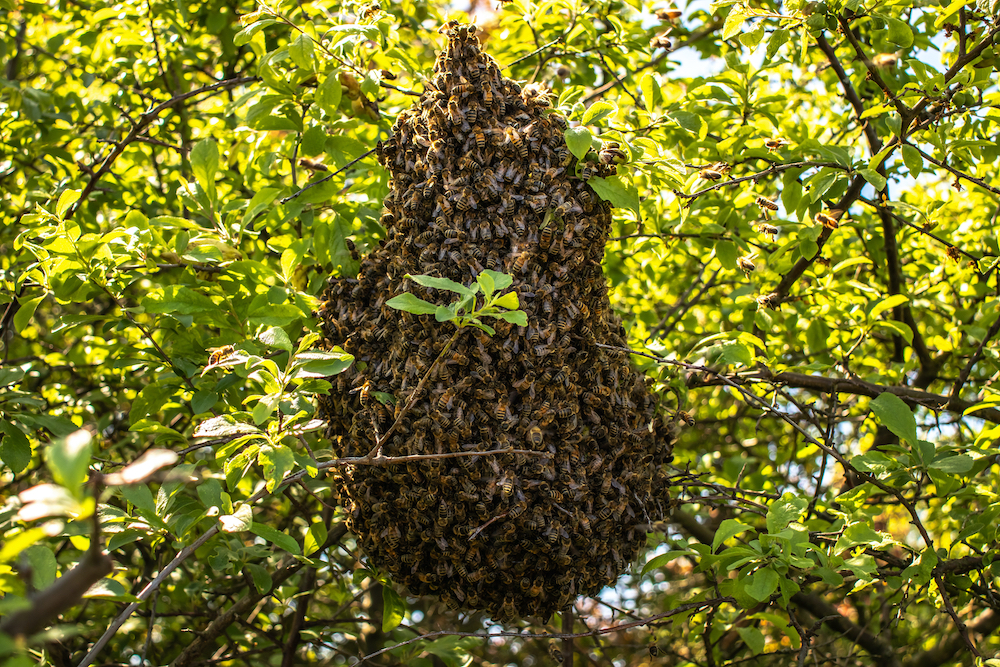Because swarming is mainly due to overcrowding, when bees are likely to swarm, there will be lots of activity outside the hive for a few days, with many bees hanging outside. In the hours leading up to a swarm, bees inside the hive are getting ready, and worker bees will begin to fill their honey crops. Bees rush around and vibrate the hive, making the other bees restless. Although the signal that lets bees know it is time is unknown, there is a specific time when bees begin to pour out of their hive and form a mass in the air. Swarms swirl around in the air, and the sound of their collective buzzing is audible and a bit scary when they are close. The good news is that swarms are not out to sting people. If a swarm gets close to you, it is simply because you are in the way of where the bees are trying to go.
The Swarming Process
The first bees to leave the hive are the queen and her reliable worker bees that are on the younger side (3 weeks). A swarm departure is quite dramatic, and bees are visually excited and have a purpose. Initially, swarming bees will find a site near the hive they just left, leaving a clear path to this temporary site, and more bees will come to this site. As more and more bees come to the temporary site, the mass may appear to be dripping with bees as they form a moving cluster.
Swarm clusters will stay for a short window of time in this location as scout bees seek a spot for their new hive home. It is believed that in some cases, scout bees have already been out looking before the swarm, but once the bees are committed and leave the hive, the situation is more urgent. Once scouts find potential locations, they come back to the swarm and do a waggle dance to share information about the location. Other bees from the swarm will go to different locations until one is chosen as the favorite. Once the site is determined, a small group of bees will fly to the new location. Then, just as quickly as they formed in their temporary location, the swarm is gone. The entire swarm will detach from the cluster, move together, fly to their new location, and start building a new hive.
Swarms Are Temporary
Some swarms may be tens of thousands of bees, which can be an intimidating sight for people just going about their business. However, bee swarms are temporary and will move on their own. Typically, swarms last a few hours a day. Infrequently, if bees are not able to agree on an ideal location for their permanent hive due to rainy weather or other unusual circumstances, it may take more than one day. Bees that swarm are in transit and moving from their original home to a new one, so unless the location of the temporary swarm poses an immediate risk to people, it is better to leave them alone. If there are situations where a swarm must be addressed before it moves on, contact a reputable and experienced live and humane bee removal company. Many local beekeepers are happy to come and may try to relocate the live bees to their apiary in the area. Sometimes swarms end up in precarious spots, like the wing of an airplane that is grounded or a baseball field fixture during a big game. Since bees are wild, they have no concept of the inconvenience their swarming may cause and do not care.

Get help with your beehive or bee swarm removal! Call Today 760-224-3040 Or 951-265-8292!
Beekeepers May Attempt to Capture a Swarm
Experienced beekeepers may attempt to capture and relocate a swarm to their bee yard or apiary. In most circumstances, the opportunity to successfully do this is quickly after the swarm has settled in its temporary location. If the swarm is settling, the scouts are still out searching, and there is plenty of honey to eat. However, as more time passes, the bees can become upset due to depleting food sources.
If you find a swarm and are concerned about the risk it poses and are unable to wait for it to move on, it is better to contact a reputable bee removal company or local beekeeper sooner rather than later. Swarms can be large and consist of tens of thousands of bees, and if they feel threatened, they may sting, so never attempt to move a swarm on your own. Even if a person is not allergic to bees, the stings of numerous stings can make a person very sick and worse.
D-Tek has the most experienced bee technicians in San Diego and Orange County, all the necessary equipment, and offers prompt responses to swarm and beehive help requests. Call us today at 760-224-3040 and let us help you handle your live bee concerns.
